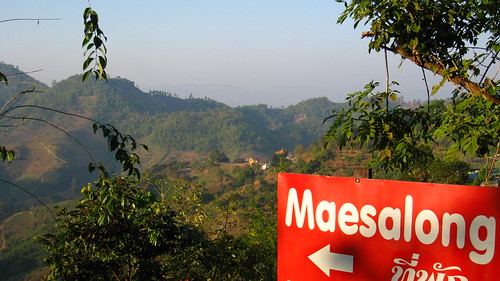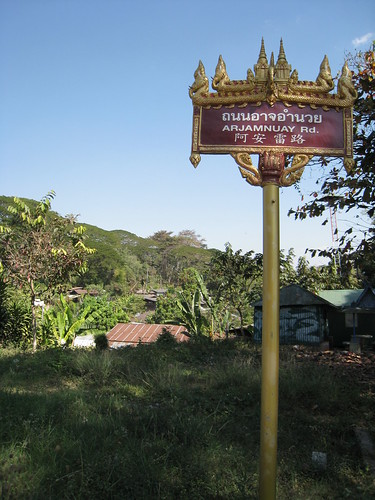 Mae Salong is a wonderful small town sitting atop a mountain ridge in northern Thailand. It is one of the least Thai parts of Thailand because it was settled by Chinese nationalist troops. The KMT (Kuo Min Tung Chinese) arrived in Mae Salong after losing China to the communist forces. They originally settled in the Shan state of Burma and launched two large scale raids into China (supported by the CIA) both of which were stopped by the communist troops. They turned their new home into a fortified drug den and became semi-autonomous. The Burmese were understandably not pleased to have a large mercenary force in their country and attempted to drive them out. The Burmese failed militarily but put diplomatic pressure on the US at the UN resulting in an agreement to airlift the troops to Taiwan. Not all of them left so willingly and set up camp across the border in Thailand at Mae Salong. They continued opium production and remained semi-autonomous in Thailand until the 1980s. The Thais used the KMT to help stop communist insurgents in the north. Since the 1980s with crop substitution and greater control from Bangkok the opium trade has been wiped out in the area. To this day the locals still speak Chinese (Yunnanese). When you wander around the area lots of signs are in Chinese. In my accommodation almost all of the TV channels were in Chinese.
Mae Salong is a wonderful small town sitting atop a mountain ridge in northern Thailand. It is one of the least Thai parts of Thailand because it was settled by Chinese nationalist troops. The KMT (Kuo Min Tung Chinese) arrived in Mae Salong after losing China to the communist forces. They originally settled in the Shan state of Burma and launched two large scale raids into China (supported by the CIA) both of which were stopped by the communist troops. They turned their new home into a fortified drug den and became semi-autonomous. The Burmese were understandably not pleased to have a large mercenary force in their country and attempted to drive them out. The Burmese failed militarily but put diplomatic pressure on the US at the UN resulting in an agreement to airlift the troops to Taiwan. Not all of them left so willingly and set up camp across the border in Thailand at Mae Salong. They continued opium production and remained semi-autonomous in Thailand until the 1980s. The Thais used the KMT to help stop communist insurgents in the north. Since the 1980s with crop substitution and greater control from Bangkok the opium trade has been wiped out in the area. To this day the locals still speak Chinese (Yunnanese). When you wander around the area lots of signs are in Chinese. In my accommodation almost all of the TV channels were in Chinese.  Mae Salong is now famed for its tea. One of the ways that opium production was wiped out was through crop substitution with tea. The hills are covered in tea plantations. There are a plethora of tea shops in town that will let you taste the teas in an elaborate Chinese tea ceremony. They will also try and sell you Chinese tea sets, made in Taiwan. I found a 12 year old entrepreneur who sold me some green tea. The whole transaction was tricky because she didn't speak a word of English, my Thai is basic and I don't speak Chinese. Apart from the Chinese and tea, Mae Salong is also surrounded by hill tribe villages. It is very easy go off on walks across the surrounding hills and pass through lots of different villages. Akha women in full tribal dress are a regular sight in town. One of the highlights of staying in Mae Salong is the morning market. It is the most intimate charming market that I have visited in Thailand. It is very small and attracts people from the hill tribes aswell as the local Chinese.
Mae Salong is now famed for its tea. One of the ways that opium production was wiped out was through crop substitution with tea. The hills are covered in tea plantations. There are a plethora of tea shops in town that will let you taste the teas in an elaborate Chinese tea ceremony. They will also try and sell you Chinese tea sets, made in Taiwan. I found a 12 year old entrepreneur who sold me some green tea. The whole transaction was tricky because she didn't speak a word of English, my Thai is basic and I don't speak Chinese. Apart from the Chinese and tea, Mae Salong is also surrounded by hill tribe villages. It is very easy go off on walks across the surrounding hills and pass through lots of different villages. Akha women in full tribal dress are a regular sight in town. One of the highlights of staying in Mae Salong is the morning market. It is the most intimate charming market that I have visited in Thailand. It is very small and attracts people from the hill tribes aswell as the local Chinese.
 I had intended to travel directly to Mae Salong from Chang Mai. I caught a bus to Tha Ton and arrived at 2.30pm only to discover that Sangthaews only go up to Mae Salong between 7am and 1pm. There was, hoiwever, a bus to Mae Sai at 3pm so I jumped on that. Sangthaews only run back down to Tha Ton from Mae Salong until 3pm and back to Ban Pasang before 1pm. Mae Sai is the northern most town in Thailand. It is a border crossing into Burma. It is a much bigger, busier town than I expected. After dark I felt a touch uncomfortable walking around, a feeling I hadn't had in Thailand. A regular Sangthaew runs between the bus station and the border for 10B. You are dropped off at the bridge, accommodation runs along the river to the right of the bridge. To find it walk to the left of the immigration office on the bridge and you will come to a covered street with stalls, follow this along and you will find different accommodation lined along it. I ended up staying in Riverside Guesthouse which was damp and tatty, and expensive at 400B. The next morning I caught a Chang Rai bound bus to Ban Pasang. I waited 2 hours for 5 more people to show up to share a Sangthaew with. We paid 70B each (it would have been 50B with 7) to go up to Mae Salong. I stayed at Shin Sane guesthouse, run by a very happy go lucky Chinese guy. I paid 200B for a bungalow with ensuite hot shower. It gets cold at night and a hot shower is a must in my book. Three guesthouses are grouped next to one another. There are also more expensive ones further afield.
I had intended to travel directly to Mae Salong from Chang Mai. I caught a bus to Tha Ton and arrived at 2.30pm only to discover that Sangthaews only go up to Mae Salong between 7am and 1pm. There was, hoiwever, a bus to Mae Sai at 3pm so I jumped on that. Sangthaews only run back down to Tha Ton from Mae Salong until 3pm and back to Ban Pasang before 1pm. Mae Sai is the northern most town in Thailand. It is a border crossing into Burma. It is a much bigger, busier town than I expected. After dark I felt a touch uncomfortable walking around, a feeling I hadn't had in Thailand. A regular Sangthaew runs between the bus station and the border for 10B. You are dropped off at the bridge, accommodation runs along the river to the right of the bridge. To find it walk to the left of the immigration office on the bridge and you will come to a covered street with stalls, follow this along and you will find different accommodation lined along it. I ended up staying in Riverside Guesthouse which was damp and tatty, and expensive at 400B. The next morning I caught a Chang Rai bound bus to Ban Pasang. I waited 2 hours for 5 more people to show up to share a Sangthaew with. We paid 70B each (it would have been 50B with 7) to go up to Mae Salong. I stayed at Shin Sane guesthouse, run by a very happy go lucky Chinese guy. I paid 200B for a bungalow with ensuite hot shower. It gets cold at night and a hot shower is a must in my book. Three guesthouses are grouped next to one another. There are also more expensive ones further afield. From Mae Salong I stopped in Chang Rai. Chang Rai is a very quiet town with nothing of any real note. The night market is good and there are a couple of good temples. The Hill Tribe museum is well worth visiting and has alot of information regarding the tribes in the Golden Triangle. I choose not to go hiking to hill tribes in Northern Thailand because I have heard bad reports about it from fellow travellers. I have been told many stories where treks from Chang Mai are well worn paths full of tourists heading up to markets where tourists gawk at the hill tribe people and take photos. Until I went to the Hill Tribe museum I didn't realise that one of the premier hill tribe attractions, the Karen long neck tribe, was even more exploitative. The Karen are not native to Thailand, they come from Burma. They fled Burma and are refugees in Thailand. They are placed in prison camps outside the main refugee camps where tourists can come and visit, pay an entry fee and take photos. The UNHCR has now got involved, click here to read an article on BBC News about it.
From Mae Salong I stopped in Chang Rai. Chang Rai is a very quiet town with nothing of any real note. The night market is good and there are a couple of good temples. The Hill Tribe museum is well worth visiting and has alot of information regarding the tribes in the Golden Triangle. I choose not to go hiking to hill tribes in Northern Thailand because I have heard bad reports about it from fellow travellers. I have been told many stories where treks from Chang Mai are well worn paths full of tourists heading up to markets where tourists gawk at the hill tribe people and take photos. Until I went to the Hill Tribe museum I didn't realise that one of the premier hill tribe attractions, the Karen long neck tribe, was even more exploitative. The Karen are not native to Thailand, they come from Burma. They fled Burma and are refugees in Thailand. They are placed in prison camps outside the main refugee camps where tourists can come and visit, pay an entry fee and take photos. The UNHCR has now got involved, click here to read an article on BBC News about it.
No comments:
Post a Comment